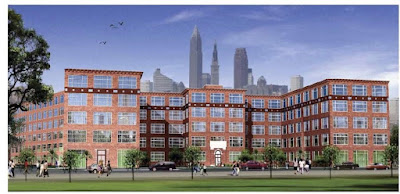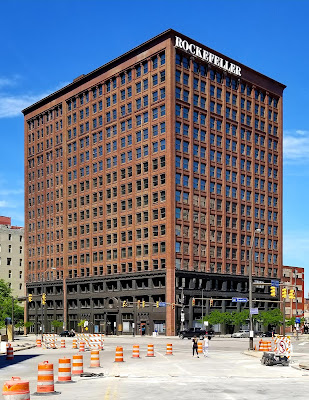Transportation officials are seeking to begin formal planning and design work for a multi-purpose pathway on the long-closed streetcar subway deck of the Detroit-Superior Veterans Memorial Bridge. The bridge over the Cuyahoga River valley links downtown Cleveland and the Hingetown section of Ohio City.
Cuyahoga County Public Works Director Michael Dever acknowledged in a recent phone interview the county's desire to start the project which he said might cost about $18 million in 2024 dollars. That year is significant, as it indicates when Dever hopes major construction will be underway on the project.
"Our desire is to convert the underside of the bridge to a pedestrian walkway," Dever said. "In conjunction with the development of Irishtown Bend Park, this will be a great link between Ohio City and Downtown Cleveland."
The path's final design has yet to be undertaken and county funding has yet to be allocated to the bridge project. Dever says the reason is that the assignment of maintenance responsibilities of the proposed pathway remains unresolved.
Brent Kovacs, public information officer at the Ohio Department of Transportation's (ODOT) District 12 office, said ODOT is a partner in the discussions about the subway deck path with the county, city and the Northeast Ohio Areawide Coordinating Agency (NOACA). However, he said there is no timeline yet for moving forward.
 |
| The Detroit-Superior bridge is one of Cleveland's most iconic structures and, thus, one of its most photographed (KJP). |
"The project needs to be developed further to determine possible funding," Kovacs said in an e-mail to NEOtrans. "NOACA is working with all parties mentioned above to set up a future meeting for discussion. In general when it comes to the Detroit-Superior bridge, ODOT funding would be for construction and long term maintenance. The city is responsible for routine maintenance."
A source who does not wish to be identified said the planning process has been slowed because Cleveland Public Works Director Michael Cox and other Jackson Administration officials have yet to respond to requests to participate in the project. Cox did not respond to e-mails from NEOtrans seeking comment.
Dever said the county's vision for the pathway is based on a 2013 conceptual study funded by eight partners led by the Northeast Ohio Areawide Coordinating Agency and conducted by a design team led by Kent State University's (KSU) Cleveland Urban Design Collaborative (CUDC).
CUDC's vision was to convert the center axis of the bridge's streetcar subway into the pathway, leaving the south side of the bridge for utilities. The north side of the bridge was to see a mix of uses. Portions would remain unused. Other spans of the 13-span viaduct would feature permanent or temporary art exhibits.
The Detroit-Superior bridge was opened to roadway and rail traffic in 1918. It replaced the 1878-built Superior Viaduct which had a swing span over the Cuyahoga River to let large boats pass. The newer bridge was tall enough so the largest ships could travel below it without affecting road and rail traffic on it. The subway deck was closed to rail traffic in 1954 and has been largely unused ever since.
The county's vision for reusing it is to put the pathway along the south side of the subway deck where utility lines now run, Dever said. Those utility lines would be removed. The pathway's alignment would allow the northern two-thirds of the bridge's subway deck to remain for other uses. The bridge's center axis is currently used by service vehicles to inspect and make occasional repairs to the roadway deck above.
The subway stations -- one at West 9th Street at the east end of the bridge and the other at West 25th Street at the west end of the bridge -- would remain vacant. The pathway would bypass each station, ramping up and down from the subway deck outside of box-like structures containing the stations in each end of the bridge.
At the west end of the bridge, the path was proposed in the CUDC study to emerge from the south side of the bridge and ramp up to street level next to a derelict building owned by developer and restaurateur Bobby George. He acquired it in 2018 for $248,200 as planning advanced for the adjacent Irishtown Bend Park. Sources said he is apparently asking $7.2 million for the 0.4-acre property.
In the years since the CUDC study was done, the Lakefront Bikeway Connector was built to reach Gordon Square and Edgewater Park. The Detroit-Superior subway path could connect to it via a public space proposed as part of the planned 16-story Bridgeworks tower, 2429 Superior Viaduct, said Tom McNair, executive director of Ohio City Inc. Ohio City Inc. was a collaborator in the CUDC study in 2013.
"This path is the type of thing that gives pedestrians more choices," he said. "The county has been looking at moving this (subway path) forward for some time. It influenced us to look at things around it. There's lots of projects around it. The big challenge is how to prioritize those projects and integrate those projects with the bridge."
 |
| One of many streetcar subway tours over the years was held July 6, 2013 by Cuyahoga County Public Works with the support of the City of Cleveland and the Ohio Department of Transportation (KJP). |
In the CUDC report, it showed the path at the east end of the bridge would both rise and descend from the subway deck. The rising path would climb to the southwest corner of Superior and Huron Road. The descending path would use switchback ramps to drop to the valley floor and the planned Canal Basin Park where it would connect with the Towpath Trail.
Although the bridge sets on county-owned land, responsibility over maintenance of the bridge rests with the city; much of the funding comes from ODOT. The bridge carries the route designations for State Route 3 and U.S. Routes 6, 20 and 42.
The complex mix of responsibilities for the bridge is reflected in the approvals process for self-guided subway deck tours hosted by the county. The tours, occasionally held on major holiday weekends from Memorial Day to Labor Day, must be approved by both the city and ODOT, Dever said.
There won't be any subway tours this year and not just because of the pandemic. Dever said ODOT is funding major concrete repairs to the underside of the bridge. The repairs are projected to cost $16 million and continue until October.
Ward 3 Councilman Kerry McCormack expressed his support for developing the subway deck. He also has been convening stakeholder meetings on developing Superior Viaduct into a linear park. That could involve moving up to 150 parking spaces from the viaduct to an unidentified parking structure.
The Bridgeworks development has a 200+ space parking structure included in its plans that were approved by the city's Landmarks Commission in April. But the development is either too expensive as designed or doesn't yet have enough financing to start construction, according to two sources who spoke off the record. Reducing the amount of parking or finding a new, cheaper place to put the parking could make the project feasible.
Mike Panzica, part of Bridgeworks development team with Graham Veysey and others, did not comment on the project's finances or the neighborhood's parking situation. He said his team intends to move forward with the plan as approved by the city.
"We intend to demolish the county (engineer's) laboratory building for the parking garage," Panizca said. "Our goal is to break ground (on the tower) later this year."
Bridgeworks is designed to add 170 apartments and 130 hotel rooms, the latter offered by an as-yet unidentified hotel chain. There will also be ground-floor restaurants/cafes and retail, as well as an 11th-floor restaurant.
"Potentially, there's a real opportunity to have (parking) spaces that are used by residents in the evening that can be used during the day for office tenants nearby," McNair said of Bridgeworks' proposed parking deck.
 |
| The Detroit-Superior bridge and its subway deck dominate the view from the Stonebridge Condominiums (KJP). |
A neighbor of the Bridgeworks development has been shopping another idea on how to address a worsening parking shortage in the area -- use part of the Detroit-Superior bridge's subway deck.
Terry Coyne, vice chairman of the Cleveland office of real estate broker Newmark Knight Frank, owns an historic, three-story office building at 2401 Superior Viaduct. Its largest tenant, a 102-employee video streaming company called BoxCast, is growing fast.
Coyne said BoxCast needs more parking or the company may move. Even with the planned pathway in place, the Detroit-Superior bridge's subway deck has more than 80,000 square feet of unused space west of the span directly above the Cuyahoga River. If converted to parking, it could accommodate up to 250 parked vehicles.
"I would be happy to pay for access to that space," Coyne said. "It would solve a lot of parking issues."
"After I lived in Spain for two years, I became a big supporter of transit-oriented development," McCormack said. "It's not hard to see this area of the Flats and Ohio City has a serious parking problem. So I'm looking for creative solutions."
 |
| Potential uses for the subway deck at the west end of the Detroit- Superior bridge, in addition to the proposed pedestrian/bicycle path, could include up to 250 parking spaces (Google/KJP). |
According to county records, the bridge's subway deck west of the river span has three sections with different conditions that would have to be addressed before parking could be added to it. The middle section, accessible from the Bridgeworks site, appears to be the most parking-ready. It has a solid floor and fewer columns supporting the overhead roadway deck, allowing more room for cars to maneuver and park.
The section east of it also has fewer support columns but the northern side of the bridge has no solid floor; that floor would have to be added. Each arching bridge span may be strong enough to handle the added floors plus dozens of cars and SUVs. The reason is the bridge was designed to support much more weight than it does now on as many as six streetcar tracks. Only four tracks were actually provided, however.
Two-car trains of streetcars in 1918, like those designed by Cleveland Railway Commissioner Peter Witt, weighed 142,000 pounds without any passengers. That weight is roughly equal to 28 full-size SUVs. And, as designed, six of those trains could be simultaneously traversing any one span of the bridge.
The farthest west section is the old West 25th subway station. Although the western section has a solid floor, cars cannot easily maneuver in there let alone park. There are many support columns that would have to be removed and a new overhead roadway deck added, supported by long-span beams. The sides of the subway station and its street-side access points could be refurbished to their original, 1918 glory.
But converting a significant portion of the former subway deck to parking seems ironic, if not unfortunate, McNair said.
"Tenants are growing and looking for parking space," he acknowledged. "We're really big proponents of alternative modes of transportation and not over-burdening our built environment with cars. We want to engage the community to find solutions."
END



















